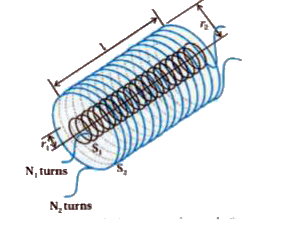InterviewSolution
Saved Bookmarks
| 1. |
Derive formula for mutual inductance for two very long coaxial solenoids. Also discuss reciprocity theorem. |
Answer» Solution :Consider figure which shows two long coaxial solenoids each of length L. We denote the radius of the inner solenoid `S_1` by `r_1` and the number of turns per unit length by `n_1`. The corresponding quantities for the outer solenoid `S_2` are `r_2` and `n_2` respectively. Let `N_1` and `N_2` be the total number of turns of coils `S_1` and `S_2` respectively.  When a current `I_2` is SET up through `S_2`, it in turn sets up a magnetic flux through `S_1`. Let us denote it by `Phi_1`. The corresponding flux linkage with solenoid `S_1` is `therefore N_1 Phi_1 = M_12 I_2` ....(1) `M_12`is called the mutual inductance of solenoid `S_1` with RESPECT to solenoid `S_2`. It is also referred to as the coefficient of mutual induction. `N_1 Phi_1=N_1A_1B_2` `N_1 Phi_1=(n_1l)(pir_1^2)(mu_0n_2I_2)` `=mu_0n_1n_2 pir_1^2 pi_2`...(2) Where `n_1l` is the total number of thuns in solenoid `S_1` . Thus, from equation (1) and (2) , `M_12=mu_0 n_1n_2 pir_1^2l`...(3) Note that we neglected the edge effects and considered the magnetic field `mu_0n_2I_2`to be uniform throughout the length and width of the solenoid `S_2`. We now consider the reverse case. Current `I_1` is passed through the solenoid `S_1` and the flux linkage with coil `S_2` is, `N_2 Phi_2=M_21 I_1`..(4) `M_21` is called the mutual inductance of solenoid `S_2` with respect to solenoid `S_1`. The flux due to the current `I_1` in `S_1` can be assumed to be confined solely inside `S_1` since the solenoids are very long. Thus, flux linkage with solenoid `S_2` is `N_2 Phi_2=N_2A_1B_1` `N_2Phi_2 =(n_2I)(pir_1^2)(mu_0n_1I_1)` `=mu_0 n_1n_2pir_1^2 pi_1`....(5) Where `n_2I` is the total number of turns of `S_2`. From equation (4) to (5), `M_21=mu_0n_1n_2pir_1^2l`...(6) Using equation (3) and (6), we get `M_12=M_21=M` (say)...(7) Equation (7) is known as RECIPROCITY theorem. We have considered air as a medium in solenoid. Instead of air medium of relative permeability `mu` is considered then `M=mun_1n_2pir^2l` `mu=mu_0mu_r=(mu_0mu_r)n_1n_2pir^2l` |
|